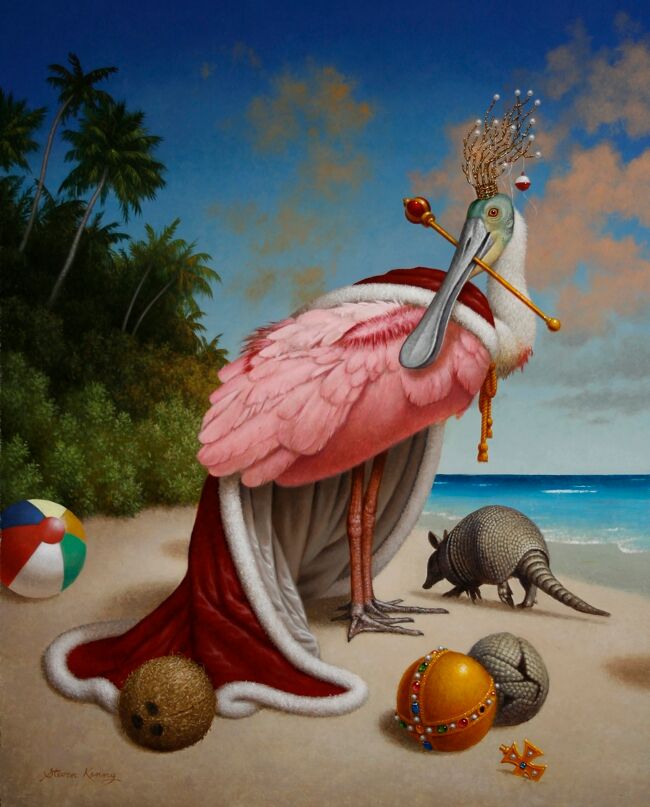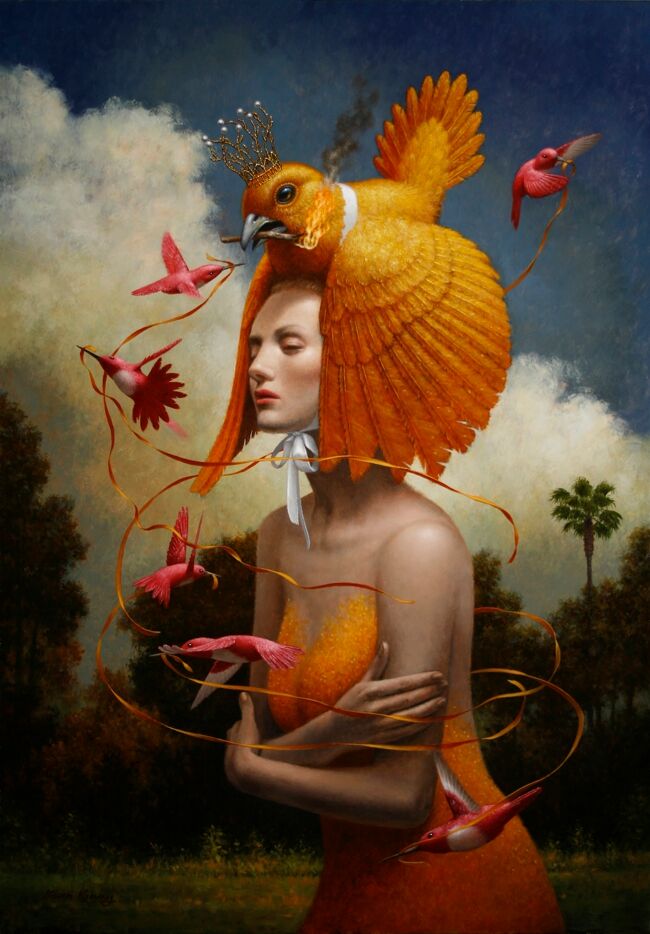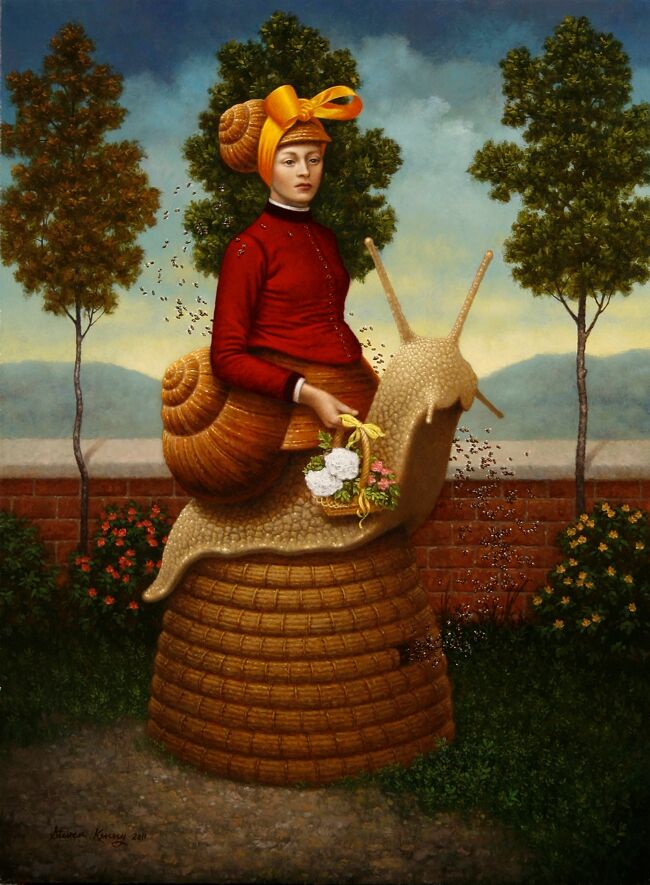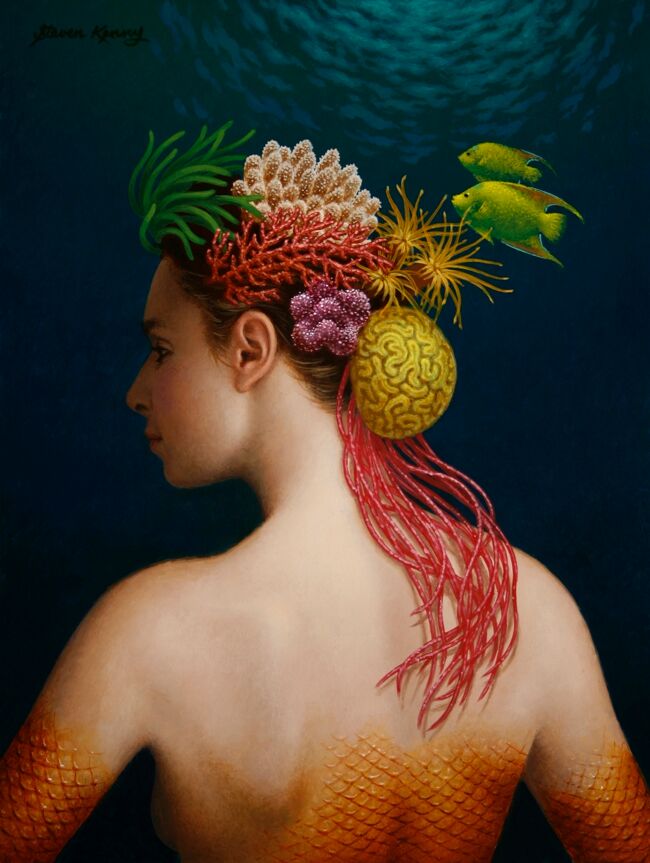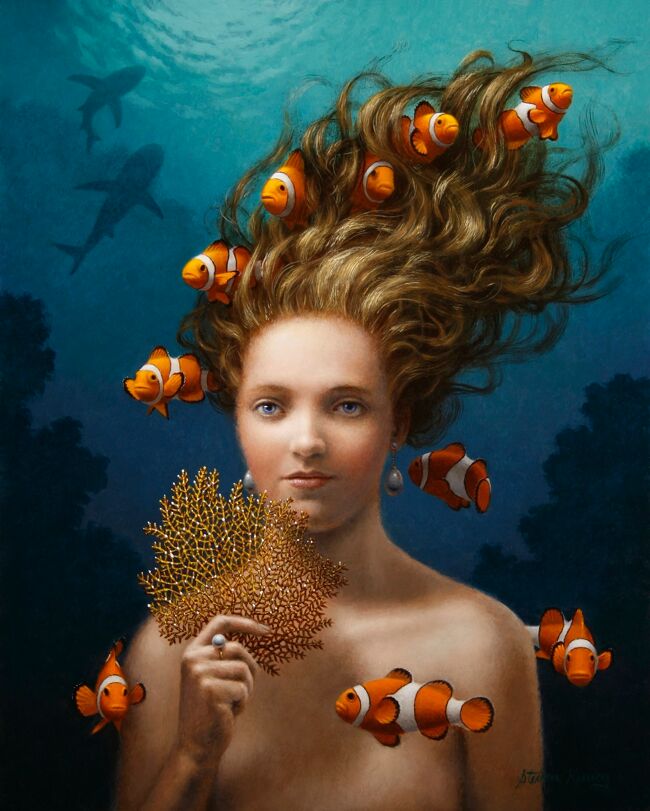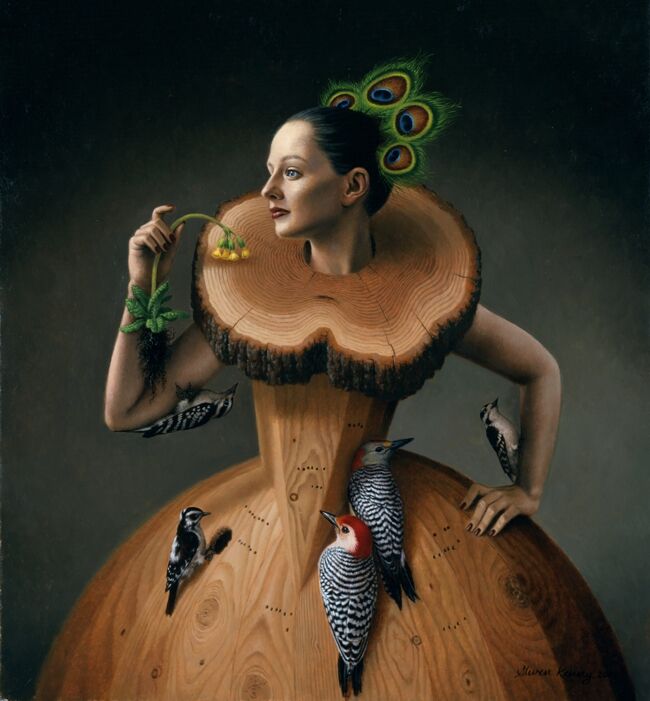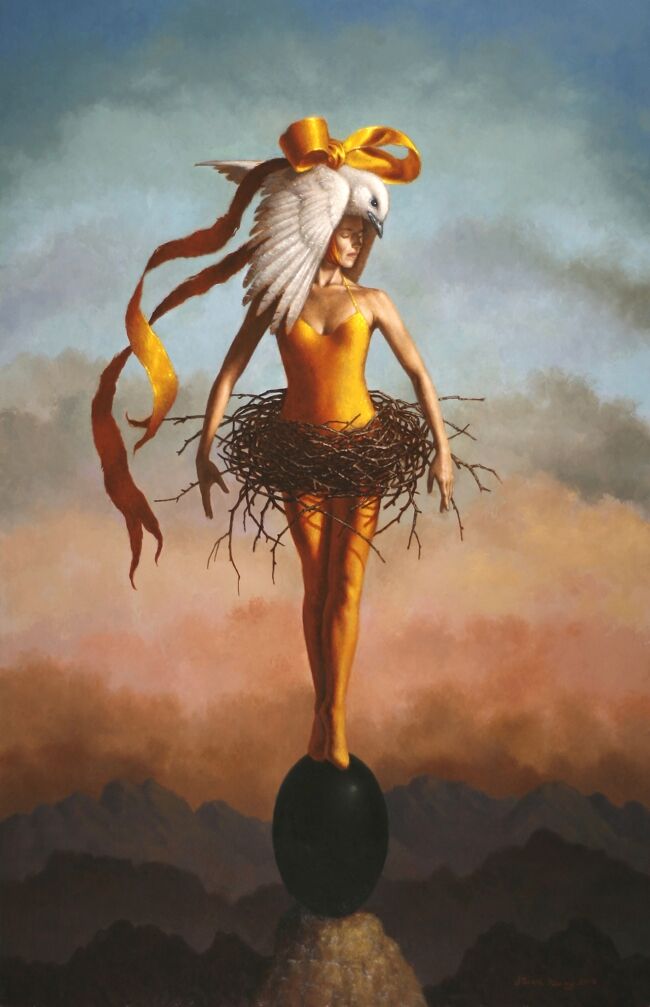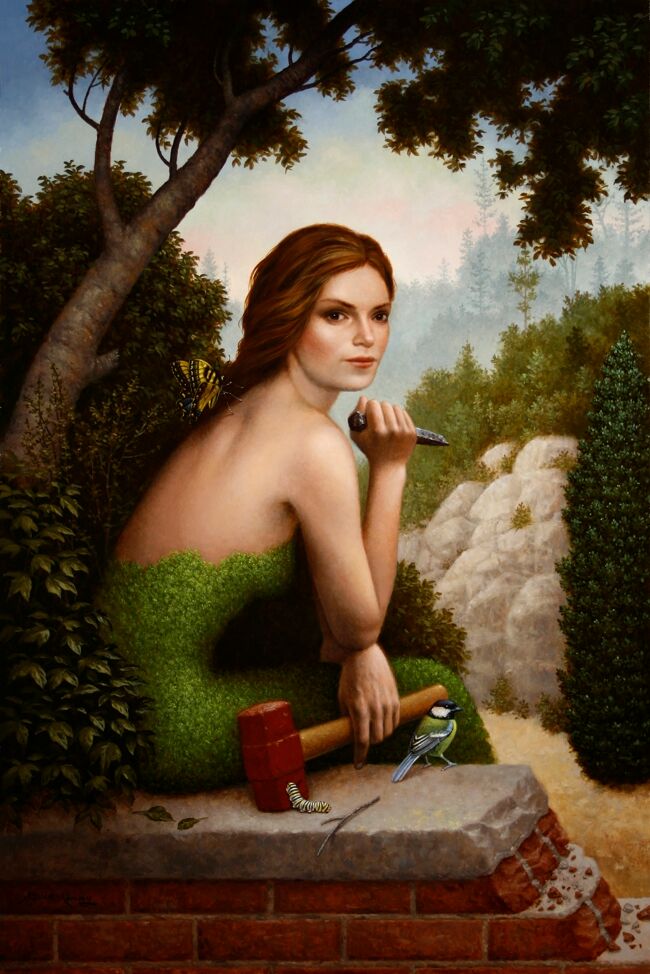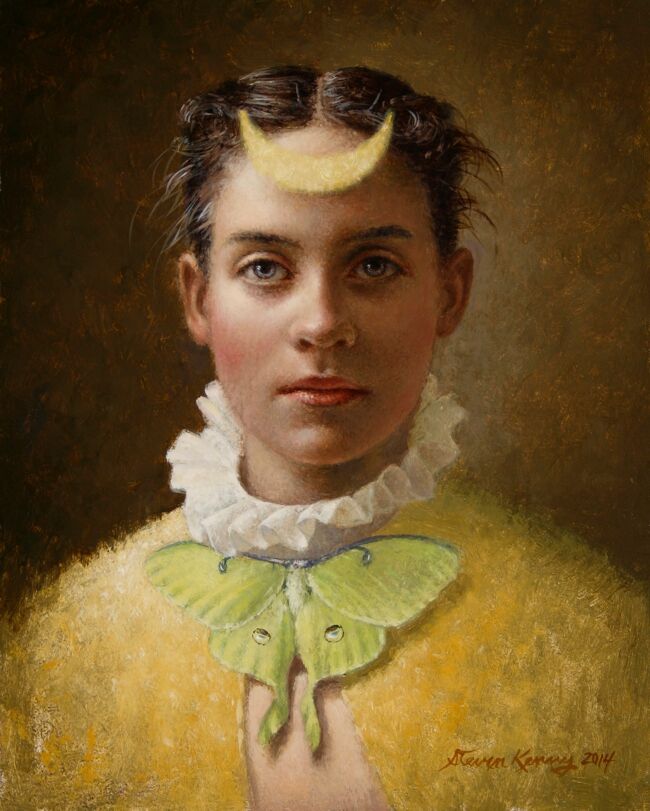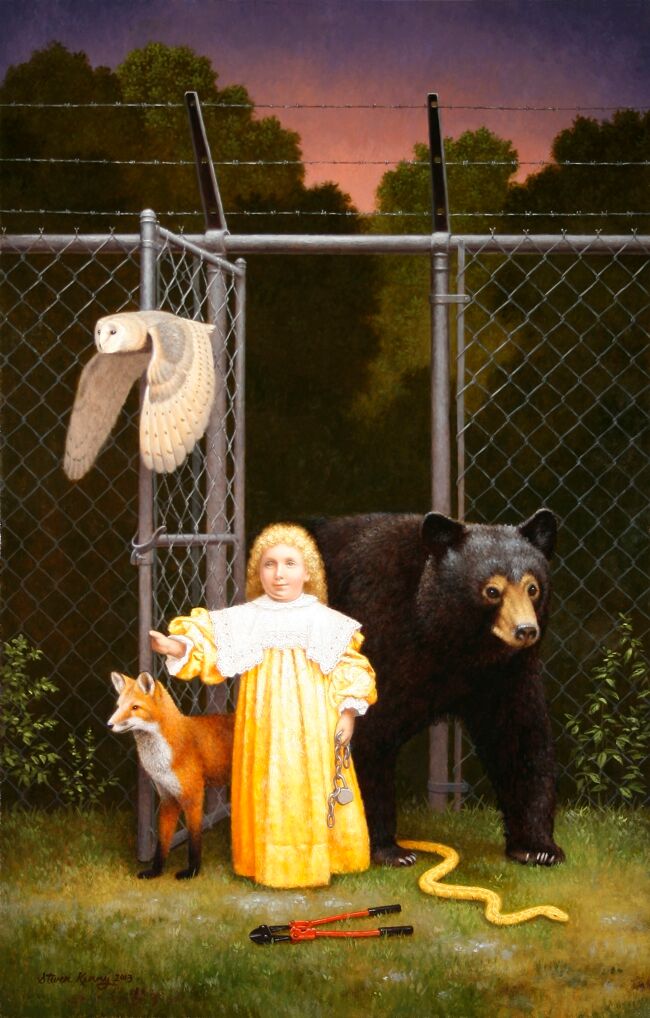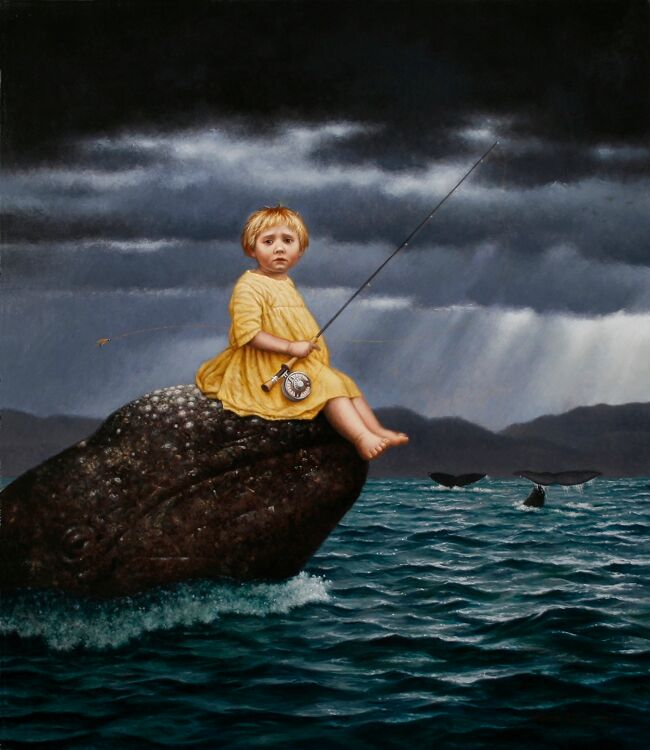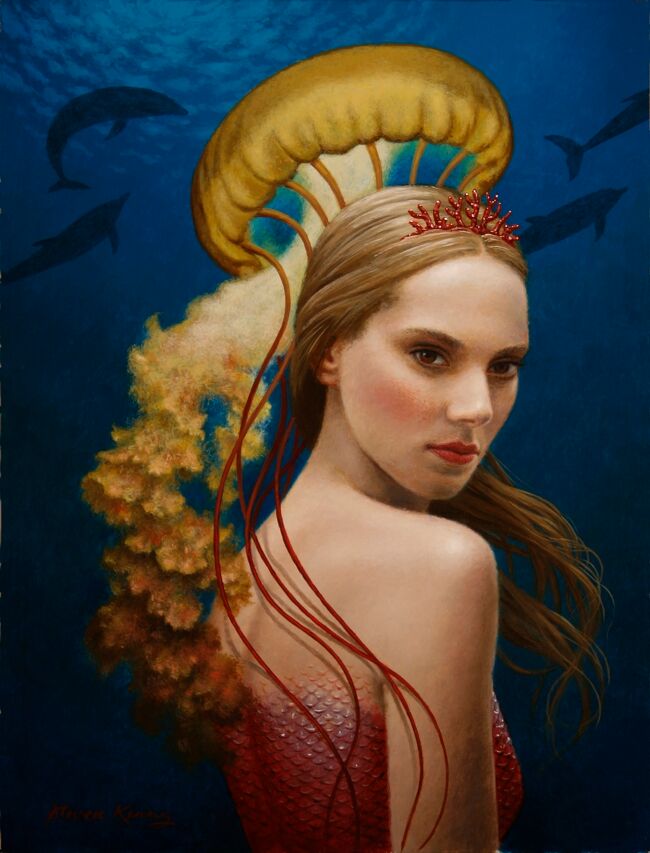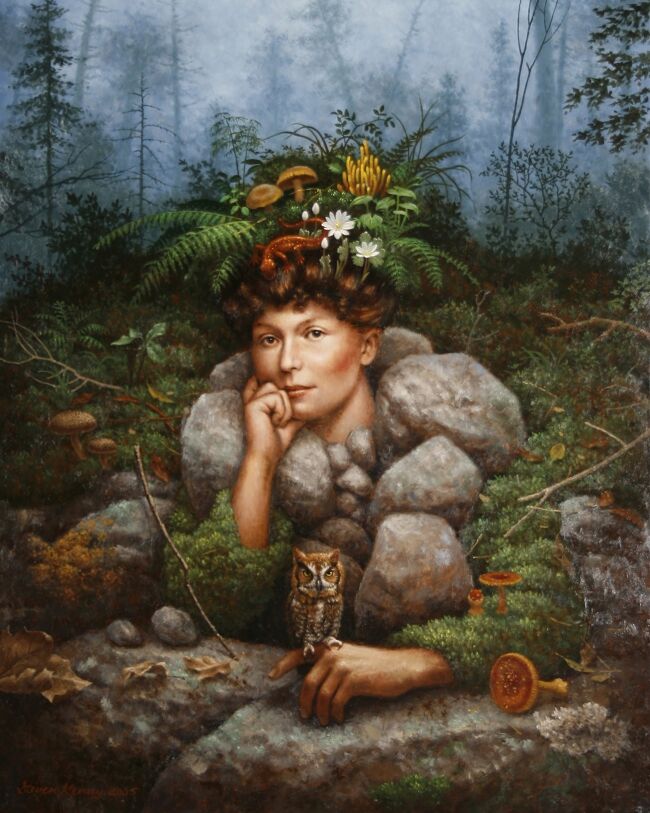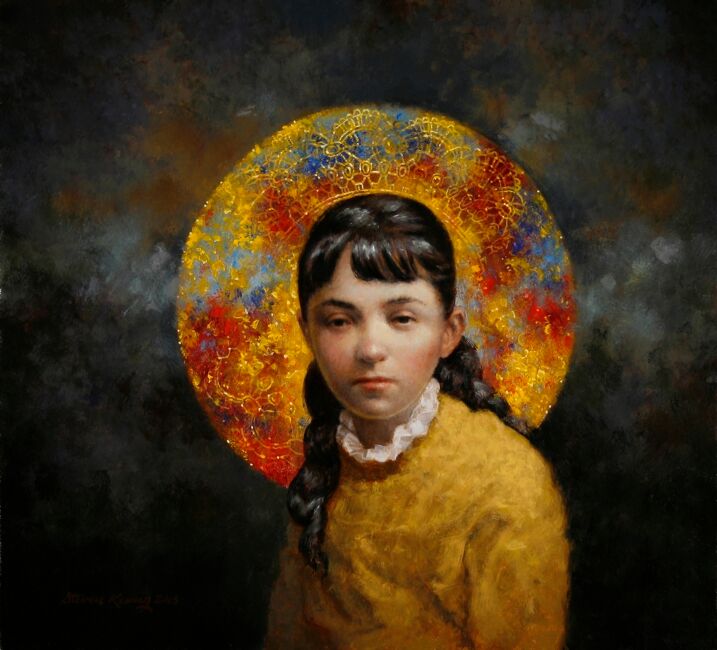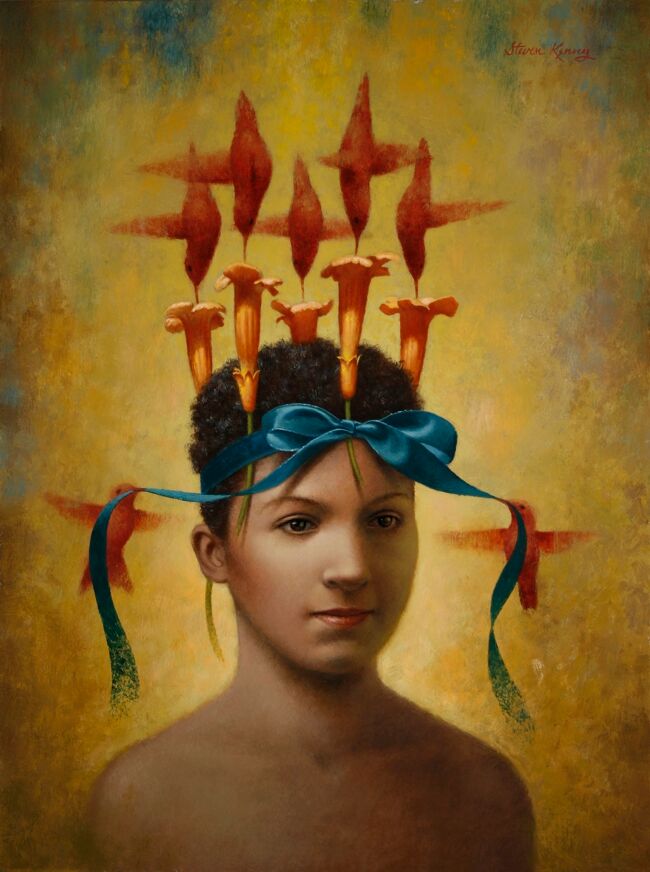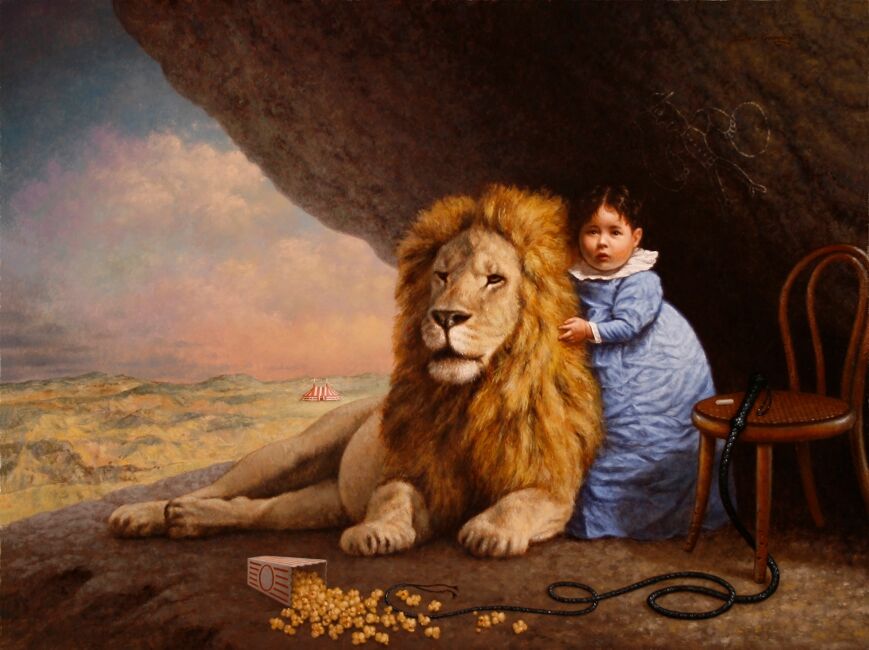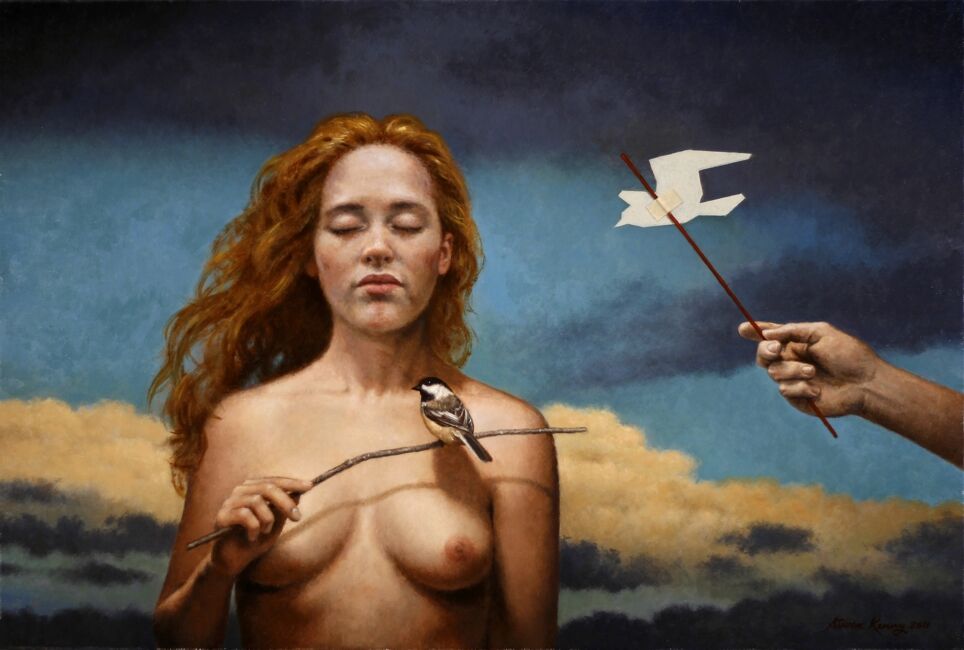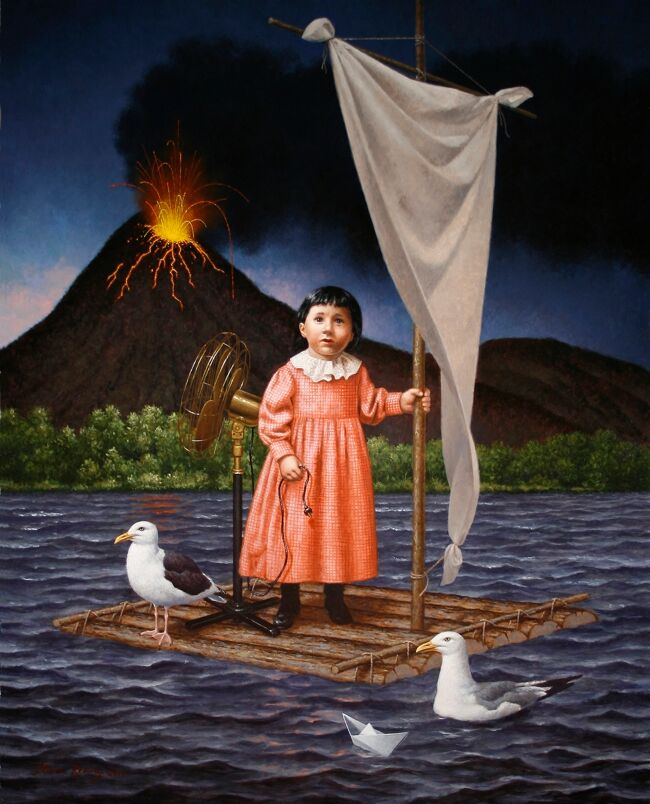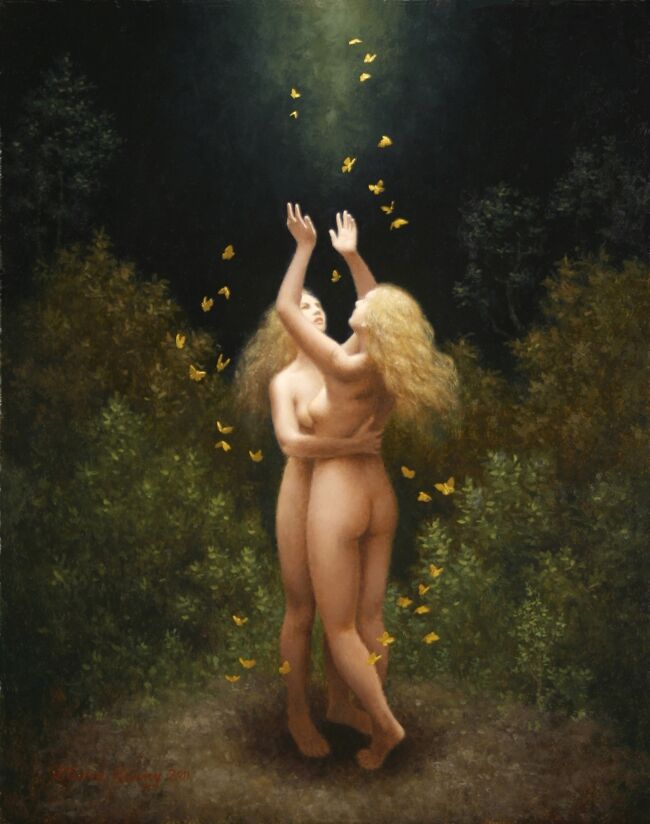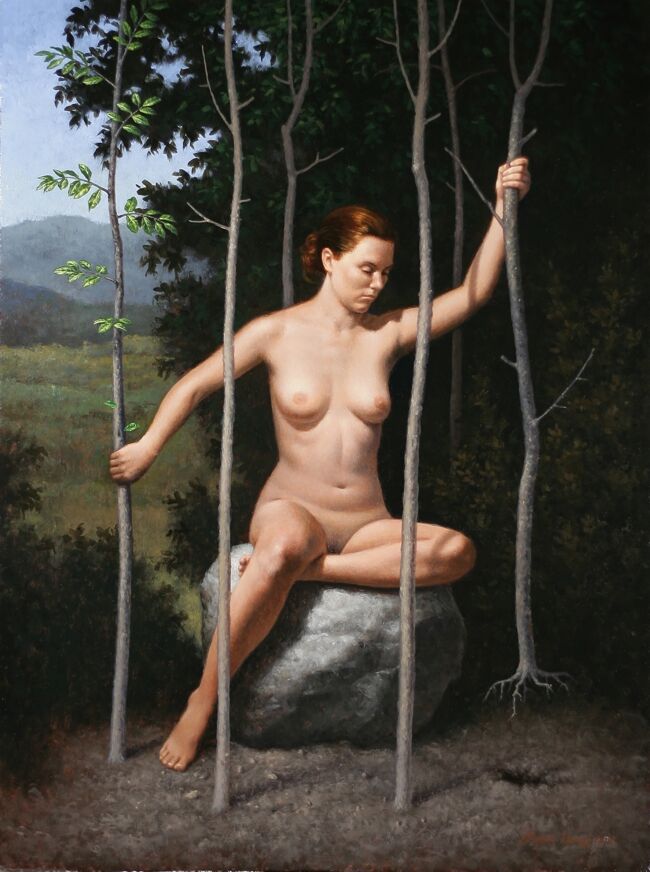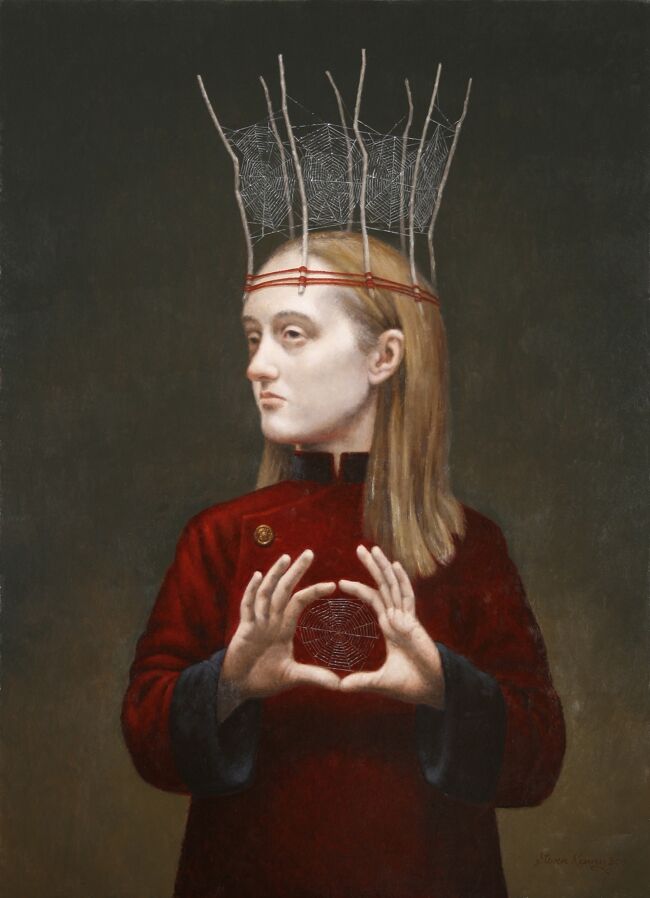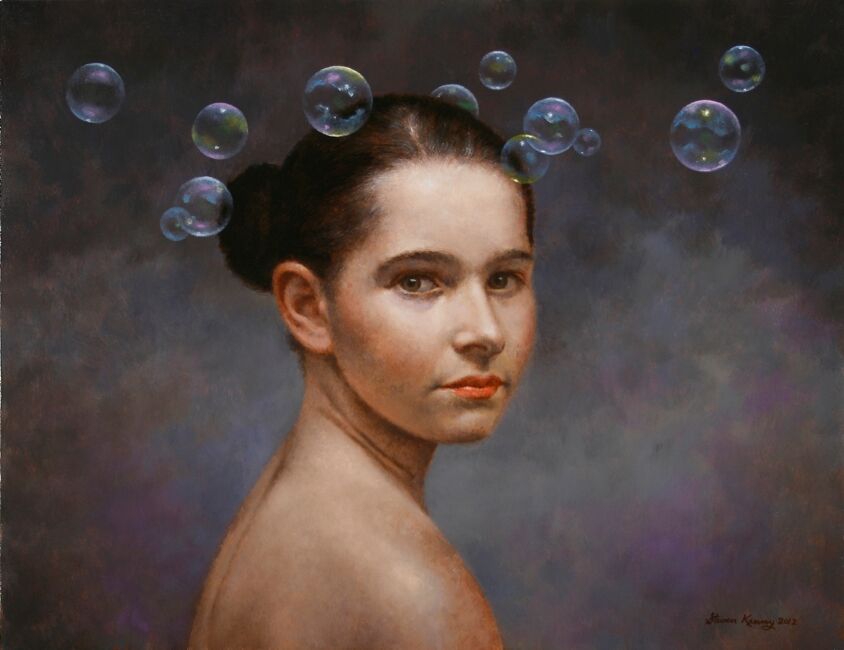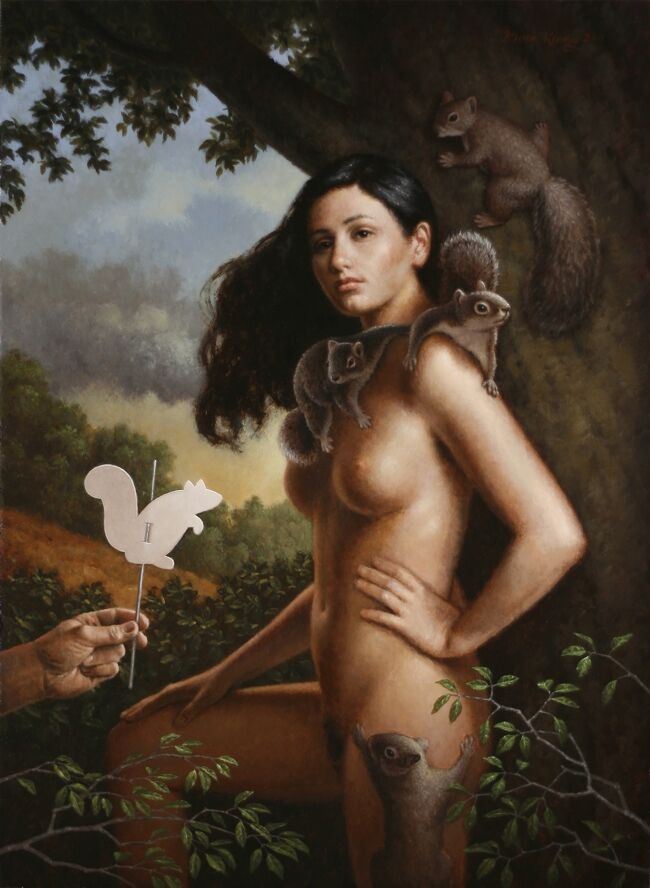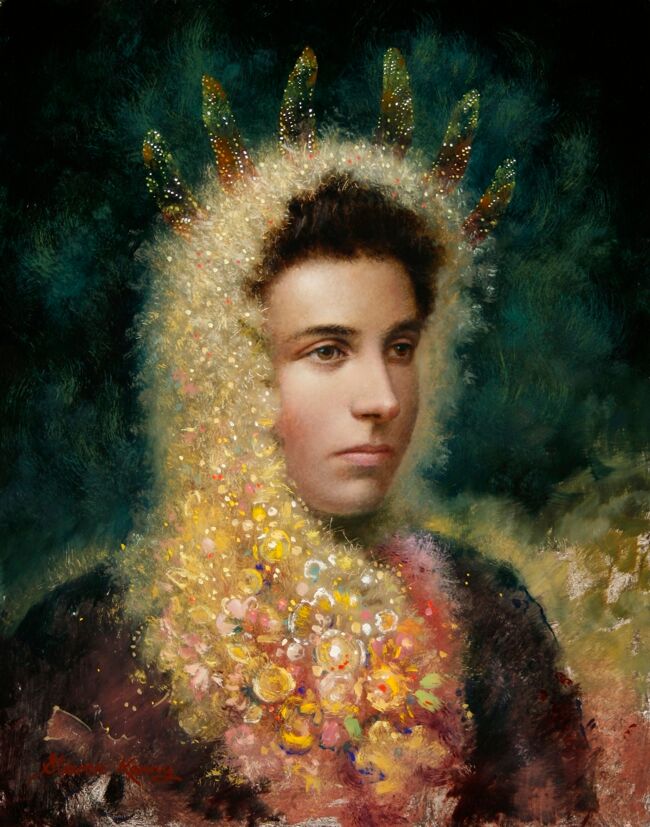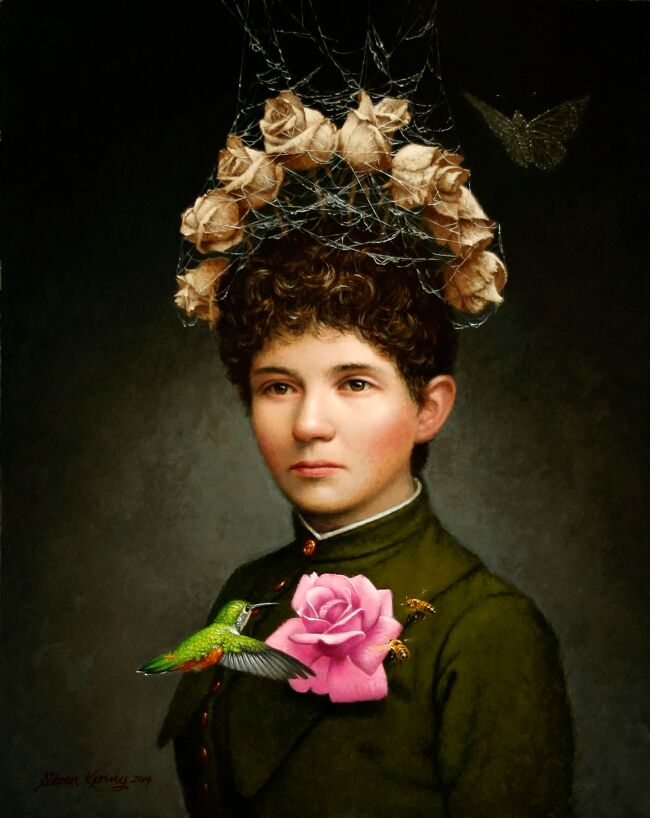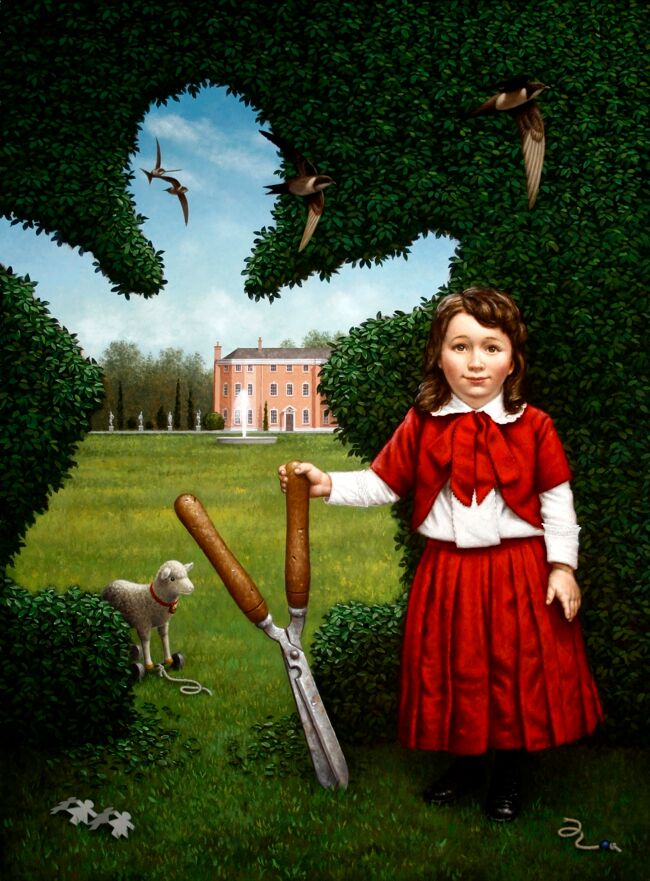Steven Kenny opens portals into a surrealistic world brimming with beautifully mysterious occurrences and relationships. Loaded with a sophisticated and versatile symbolism, which draws heavily upon Kenny’s profound connection to nature and the animal kingdom, his paintings are captivating explorations into the human condition. Through them, the artist is on a journey, uncovering facets of his own personality and exploring ideas of both his, and by default, our, kinship with, and separation from, the rest of humanity and the natural world. However, the true power of Kenny’s images lies in their ability to speak to each and every one of us on a deeply personal level. Nothing is being dictated, prescribed or forced. His paintings deal in the universal language of the unconscious mind, and as such, are hugely responsive to our own life stories and all that goes into creating our unique sense of self.
Steven Kenny was born in 1962 in Peekskill, New York. He graduated with a BFA from the Rhode Island School of Design in 1984. Over a long and successful career, Steven has exhibited his art in galleries and museums throughout the world, has won numerous awards and has been featured in countless publications.
WOW x WOW is ecstatic to have had the opportunity to pose a few probing questions to Steven. Read on to learn more about the thoughts and inspirations behind his incredible work.
Hi Steven! First of all, thanks for agreeing to free up some of your valuable time in order to have this wee chat, we really appreciate it. If you could please start us off by introducing yourself and talking about your background, touching on anything you feel has been relevant to shaping Steven Kenny the artist?
I grew up in Peekskill, New York located on the eastern shore of the Hudson River. Ironically, it wasn’t until I went to art school that I learned that the Hudson Valley has a long artistic tradition of inspiring landscape painters beginning in the 1800’s. I was the youngest of four sons in a middle-class family. We all attended a Catholic grammar school and I’m grateful for that. Although I’m not religious now, the experience did instill in me a healthy scepticism, open-mindedness, and interest in symbology. Both my parents were very good with their hands and I grew up believing that I was capable of creating anything I set my mind to.
We’re interested to hear about where you’re currently living and what you like about the area? What is the art scene like there and do you feel a part of that community?
I never dreamed that I’d find myself living in Florida, but here I am! Much of the credit goes to the Salvador Dalí Museum. Dalí’s work has had a big influence on me over the years and I wanted to visit the Dalí museum here. My wife and I came to St. Petersburg to spend a few days and we both fell in love with the city. That was almost four years ago. Another large part of the attraction had to do with the local grass-roots art scene. The creative energy was immediately apparent and we wanted to be part of it. We’ve watched it continue to blossom and there seems to be no end in sight. This city is quickly gaining a reputation as an arts destination. It’s an exciting time to be here and be a part of it all.
Once you have an idea for a painting, what’s next? What do you use in the way of reference material and how do you go about sourcing it? If you could give us some insight into how you tackle the creative process?
My creative process has evolved over the years. I began as a commercial illustrator and, as a result, needed to develop concepts fully prior to beginning a painting in order to satisfy clients’ expectations. Now, painting for myself as a fine artist, I am able to work much more intuitively. I start paintings without a clear idea of where they are going, typically beginning with just a basic concept. During the painting process, elements will enter and leave the composition. It’s a much more dynamic and exciting way of working. Reference material is almost entirely photo-based, either my own or scavenged. I want to realize my concepts as quickly and easily as possible. I have no time for working from live models. As an illustrator I learned the value of time-saving shortcuts and have no reservations about using projectors, tracing, and stencils as painting aids.
Symbolism is of vital importance to you and the way you work. Please talk to us a little about your relationship with symbolism, how it began, and how you are currently approaching the symbolic aspects of your art. Also, is there anything you could recommend to the viewers of your work who want to become better equipped to engage with symbolism in order to aid the reading, understanding and theory building of artistic intentions and narratives?
My relationship with symbolism probably began in Catholic school. The Catholic religion, especially in terms of the art that has been produced over the centuries, is drenched in representational symbolism, and could easily be categorized as surreal. From an early age I believed that reality is more than what our senses perceive. Reality is subjective and malleable. As artists, we’re obliged to express our individual perception of reality. However, for the general public, the experience of art can be seen as confrontational if it doesn’t correspond to our individual sense of what’s familiar or expected. On a fundamental level, I believe we’re hard-wired to gravitate toward the things and ideas we find reassuring and we’re repelled by that which seems foreign. However, if we were as evolved as we like to believe we are, we wouldn’t fear that which is alien, we’d be curious. So, my recommendation is to approach unfamiliar art fearlessly. I can’t hurt you. Spend a little time with it. Think. Wonder. Ask. Play. That’s what it’s there for. It’s a metaphor for life. You don’t have to like it, but at least try to have a dialogue.
Sticking with the importance of symbolism in your work for a little longer, would you say there are occasions where you don’t always necessarily have a full understanding of the symbols that appear to you and that end up in your paintings?
Initially, I intended to familiarize myself with traditional symbolism and use it in my work. I naively believed that a universal symbolic lexicon existed that could be interpreted by everyone equally. I quickly found that symbols offer different interpretations depending on cultural context. I found a way out of my dilemma as soon as I learned of Carl Jung’s work. His focus on the power of the unconscious, and its individual importance to each of us, gave me the freedom to use my own personal symbols. At this point, when beginning a painting, I try not to over-think each composition, allowing my unconscious to make suggestions. I listen closely to those impulses but also do a fair amount of editing. There’s a fine line between the two. In the end, I may or may not know why a particular image finds its way into a composition. I trust that my conscious and unconscious minds can work together.
Your unconscious mind is clearly something you nurture and look to during your creative process. Can you tell us about any techniques that you employ to tap into your unconscious or that help ideas rise to the surface?
Typically, ideas come from looking at images. I may see a figure in a particular pose or a face and it will cause me to pause without really knowing why. I collect those images that attract my attention. An idea may come immediately but most often it will come later. Other elements will come to mind when I revisit an image and the beginnings of a composition will begin to evolve. That’s when I begin painting. The concept starts to form and I just let it lead me in the direction it wants to go.
Many of the protagonists in your work appear to be in states of self-reflection and contemplative thought. Do you feel that this is a channelling of your own reflection about the images you create, or does it stem from somewhere else?
That’s a great question. I feel that many of my subjects are on the brink of making a decision. They find themselves at a still point where anything could happen next. I love that point of uncertainty. That’s the life of an artist (and everyone else, for that matter). We never really know what the next moment will bring. That’s a frightening thought, actually, but most of us simply trust that each day will be like the last, until a radical change occurs out of the blue.
The animal kingdom is one of your biggest sources of inspiration and birds feature frequently in your work. What are some of the earliest memories you have, which contributed to forming the foundation of your life-long passion for, and interest in wildlife and the symbolism it carries?
There were acres of woods across from the house I grew up in. I spent most of my childhood exploring and observing nature in all seasons. It was an invaluable education. It taught me about life, death, birth, growth, decay, change, and shaped my ideas about life in general. It gave me a broad perspective on what it means to be alive.
What do you feel is the most essential factor an artist must be open to, regarding the evolution of their practice? Having had a lengthy and successful career so far, how have you seen your own work evolve over time?
I strongly believe that the essential beauty and significance of art is that it expresses each artist’s individual experience. But, for me, the most essential factor has been not to shy away from uncertainty. In fact, my practice has been to encourage it. Yet, having said that, I know of many artists who are much more courageously creative than me and I greatly admire them for that. Ultimately, we can only do what we can. Just as in life, the joy, excitement, and disappointment come from trying new things. That doesn’t necessarily mean periodically adopting new styles or changing media, it simply means being aware of when you’re coasting and knowing how to keep yourself on unfamiliar ground. As much as I try to do that in my own work, I still find myself returning to familiar territory. An analogy might be that of being lost in a forest. We can try to reach a particular location but suddenly find ourselves back where we started. However, in the process of walking we have seen and experienced new things. We’re not the same person we were when we set out. So, looking back over my 31 year career, I can see that many aspects might appear not to have changed much. Yet, on many levels, the work is very different because I’ve grown as an artist during that time.
In order to get a better understanding of the personality of an artist, it can help to get a peek behind the curtain. Would you be willing to share a story from your own life, one which you feel has contributed to shaping the person and therefore the artist you are today?
I grew up in a very loving family and my home life was a secure one. But my childhood, both at home and in the Catholic school I attended, presented me with many intellectual and ethical contradictions. My understanding of truth and reality as it was presented to me was dependent on the various contexts I found myself in. From a very early age I learned that defining what was ‘real’ was a matter of personal perspective and I needed to decide for myself what to believe and what to reject.
What is the most memorable thing anyone has ever said about your art?
It’s not so much a matter of what they say but how they respond. What I remember most are those few times when viewers have instantly connected with my work on a deeply personal level. It rarely has anything to do with my intentions in creating a painting. Instead, the image simply strikes a resonant chord in them that I could not have foreseen. What makes it special for me is that this happens with paintings that I feel good about during and after the process of creating them. What this tells me is that if I am true to myself, being honest in how I express myself, and paint from my heart, then my work will be most likely touch another person.
If you could own any piece of art from the world’s collections, what would it be and why?
There are so many I’d like to own! But if I had to pick one it would probably be a late Rembrandt. I honestly can’t think of another painter whose dedication to their craft is so apparent in their work. I look at the late Rembrandt’s and feel as though I’m looking into him. It’s hard to explain, but I can see his persona in his brushwork and compositional choices. His honesty shines through. I see no hesitation in his labour. The images come straight from his heart and mind without pausing and with absolute certainty.
What’s next for Steven Kenny?
I really don’t have a plan other than to continue doing what I do and see where it leads me. After 31 years as an artist I can see how I’ve progressed but still struggle with self-doubt. I suppose that may never end. If it does end, I’ll know I’ll have given up.

